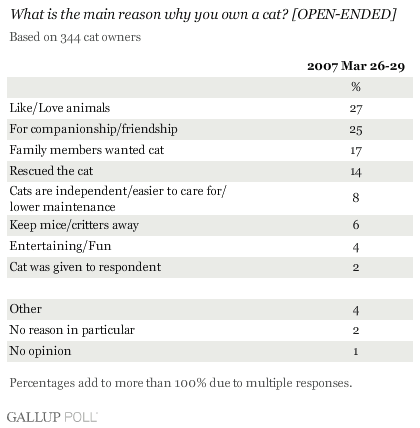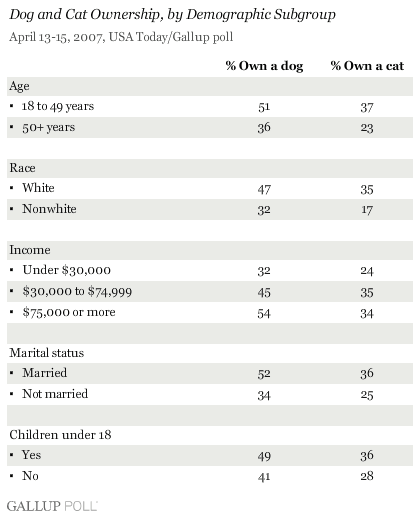PRINCETON, NJ -- Gallup surveys conducted earlier this year explored the topic of pet ownership in the United States. Roughly 6 in 10 Americans own a cat or dog, with more owning a dog than a cat. When dog and cat owners were asked why they own that particular pet, it is clear that emotions play a large part in pet ownership. In fact, 4 in 10 dog owners specifically cite companionship as the reason they own a dog, easily the top response. Cat owners are less likely to mention companionship when asked why they own a cat, but it still ties as the top reason along with a more general love of animals. Among the groups most likely to own cats or dogs are younger Americans, whites, those who are married, and those residing in higher-income households.
Fifty-nine percent of Americans own a cat or dog, including 16% who own both, 28% who own only a dog, and 15% who just own a cat. Thus, Americans are about 1 1/2 times more likely to own a dog (44%) than a cat (31%). These results are based on an April 13-15 Gallup Poll.

A separate Gallup Poll -- the March 26-29 Gallup Panel survey -- asked dog and cat owners to explain some of the reasons why they own a cat or dog. The results suggest that dog and cat ownership largely revolves around a desire for companionship and other emotional benefits provided by these pets.
Forty-two percent of dog owners say companionship or friendship is the main reason why they own a dog, easily the top response. Twenty-four percent mention a more general love of animals, and 17% say their family wanted a dog. Some dog owners do mention more practical reasons for having a dog, such as for protection or security (10%) and for hunting or exercise (5%).

Cat ownership is also largely an emotional endeavor, though dog owners' and cat owners' stated reasons differ to some degree. Cat owners are much less likely than dog owners to specifically cite companionship as the reason they own a pet, but it still is a major factor. Cat owners' top reasons for having a cat are a general love of animals and the desire for companionship.

Interestingly, a much larger percentage of cat owners (14%) than dog owners (3%) mention that they "rescued" a pet needing a new home. Cats also appeal to many pet owners because of being easier to care for -- 8% of cat owners mention responses along these lines, but dog owners do not mention this.
The practical reasons for owning a cat and owning a dog differ as well -- whereas dogs are sometimes kept for their ability to help with family security and sporting endeavors, cats are sometimes kept for their ability to aid in pest control.
Demographic Differences in Dog and Cat Ownership
Certain segments of society are more likely to own a dog or a cat than not to own one. Generally speaking, whites, younger Americans, higher-income families, and those who are married are more likely to own both cats and dogs. There are smaller differences among those who have children under 18 at home. Men and women are equally likely to own cats or dogs.

Survey Methods
These results are based on telephone interviews with a randomly selected national sample of 1,007 adults, aged 18 and older, conducted April 13-15, 2007. For results based on this sample, one can say with 95% confidence that the maximum error attributable to sampling and other random effects is ±3 percentage points. In addition to sampling error, question wording and practical difficulties in conducting surveys can introduce error or bias into the findings of public opinion polls.
Results for this Gallup Panel study are based on telephone interviews with 1,006 national adults, aged 18 and older, conducted March 26-29, 2007. Gallup panel members are recruited through random selection methods. The panel is weighted so that it is demographically representative of the U.S. adult population. For results based on these samples, one can say with 95% confidence that the maximum margin of sampling error is ±4 percentage points. In addition to sampling error, question wording and practical difficulties in conducting surveys can introduce error or bias into the findings of public opinion polls.
For results based on the sample of 455 dog owners, the maximum margin of sampling error is ±6 percentage points.
For results based on the sample of 344 cat owners, the maximum margin of sampling error is ±6 percentage points.
